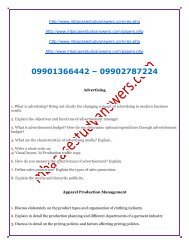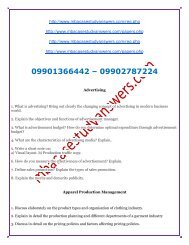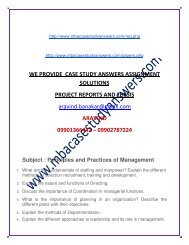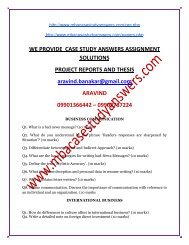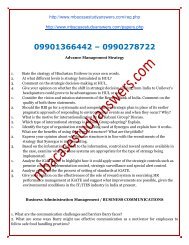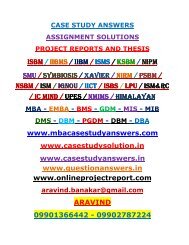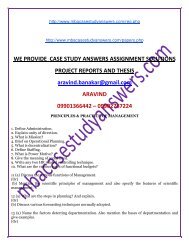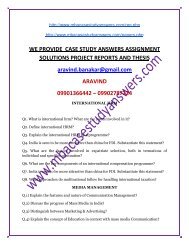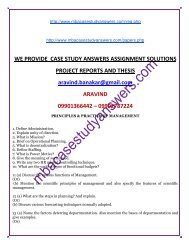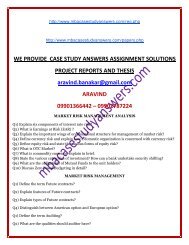Discuss merits demerits of the role of strike, agitation and legal approach in union management relations
You also want an ePaper? Increase the reach of your titles
YUMPU automatically turns print PDFs into web optimized ePapers that Google loves.
WE PROVIDE CASE STUDY ANSWERS, ASSIGNMENT<br />
SOLUTIONS, PROJECT REPORTS AND THESIS<br />
arav<strong>in</strong>d.banakar@gmail.com<br />
ARAVIND - 09901366442 – 09902787224<br />
Pr<strong>in</strong>cipal Practice Management<br />
1. What was <strong>the</strong> cause <strong>of</strong> fear <strong>in</strong> RBM?<br />
2. What were <strong>the</strong> symptoms <strong>of</strong> fear displayed by RBM?<br />
3. How did <strong>the</strong> RMO come to know <strong>of</strong> <strong>the</strong> war phobia <strong>of</strong> RBM?<br />
4. What actions should be taken to avoid build<strong>in</strong>g up <strong>of</strong> fear among <strong>the</strong> troops?<br />
Which <strong>of</strong> <strong>the</strong>se steps were taken by <strong>the</strong> <strong>of</strong>ficer?<br />
1. <strong>Discuss</strong> <strong>merits</strong>/de<strong>merits</strong> <strong>of</strong> <strong>the</strong> <strong>role</strong> <strong>of</strong> <strong>strike</strong>, <strong>agitation</strong> <strong>and</strong> <strong>legal</strong> <strong>approach</strong> <strong>in</strong><br />
<strong>union</strong> <strong>management</strong> <strong>relations</strong>.<br />
2. What <strong>role</strong> does mutual trust play <strong>in</strong> build<strong>in</strong>g <strong>union</strong>-<strong>management</strong> <strong>relations</strong>?<br />
1. What were <strong>the</strong> strengths <strong>and</strong> weaknesses <strong>of</strong> VSNL?<br />
2. Do you th<strong>in</strong>k that VSNL should have changed its thrust from basic telephony to<br />
cellular services?<br />
3. If you were <strong>the</strong> Deputy General Manager, what strategies would you have<br />
undertaken to deal with <strong>the</strong> competition?<br />
1. What environmental factors <strong>in</strong>fluenced <strong>management</strong> style at Disney?<br />
2. What k<strong>in</strong>d(s) <strong>of</strong> organizational structure seem to be consistent with “Dream<br />
as a Team” ?<br />
3. How <strong>and</strong> where might <strong>the</strong> <strong>in</strong>formal organization be a real asset at Disney ?<br />
1. How were pr<strong>in</strong>ciples <strong>of</strong> delegation <strong>and</strong> decentralization <strong>in</strong>corporated <strong>in</strong>to C<strong>in</strong>e –<br />
Made operations?<br />
2. What are <strong>the</strong> sources <strong>and</strong> uses <strong>of</strong> power at C<strong>in</strong> – Made?<br />
3. What were some <strong>of</strong> <strong>the</strong> barriers to delegation <strong>and</strong> empowerment at C<strong>in</strong> –Made?<br />
4. What lessons about <strong>management</strong> <strong>in</strong> a rapidly chang<strong>in</strong>g marketplace can be<br />
learned from <strong>the</strong> experience <strong>of</strong> C<strong>in</strong> – Made
1. With retailers as <strong>the</strong>ir primary customers, what customer competitive<br />
imperatives could be affected by Rollerblade’s <strong>in</strong>ventory problems?<br />
2. How appropriate might a just – <strong>in</strong> – time <strong>in</strong>ventory system be for a product such<br />
as roller skates?”<br />
3. What opportunities are <strong>the</strong>refore Rollerblade managers to see FOR <strong>the</strong>mselves as<br />
sell<strong>in</strong>g services, <strong>in</strong>stead <strong>of</strong> simply roller skates?<br />
Pr<strong>in</strong>cipal Practice Management<br />
1. What opportunities <strong>and</strong> threats did McDonald’s face ? How did it h<strong>and</strong>le<br />
<strong>the</strong>m ? What alternatives could it have chosen ?<br />
2. Before McDonald’s entered <strong>the</strong> European market, few people believed that<br />
fast food could be successful <strong>in</strong> Europe. Why do you th<strong>in</strong>k McDonald’s has<br />
succeeded ? What strategies did it follow ? How did <strong>the</strong>se differ from its<br />
strategies <strong>in</strong> Asia ?<br />
3. What is McDonald’s basic philosophy ? How does it enforce this philosophy<br />
<strong>and</strong> adapt to different environments ?<br />
4. Should McDonald’s exp<strong>and</strong> its menu ? If you say no, <strong>the</strong>n why not ? If you<br />
say yes, what k<strong>in</strong>ds <strong>of</strong> precuts should it add ?<br />
5. Why is McDonald’s successful <strong>in</strong> many countries around <strong>the</strong> world ?<br />
1. Can a division manager develop verifiable goals, or objectives, when <strong>the</strong> president<br />
has not assigned <strong>the</strong>m to him or her? How? What k<strong>in</strong>g <strong>of</strong> <strong>in</strong>formation or help do<br />
you believe is important for <strong>the</strong> division manager to have from headquarters?<br />
2. Was <strong>the</strong> division manager sett<strong>in</strong>g goals <strong>in</strong> <strong>the</strong> best way? What would you have<br />
done? Evaluate <strong>the</strong> formulation <strong>of</strong> <strong>the</strong> merger between Daimler <strong>and</strong><br />
Chrysler. <strong>Discuss</strong> <strong>the</strong> strategic fit <strong>and</strong> <strong>the</strong> different product l<strong>in</strong>es.<br />
2. Assess <strong>the</strong> <strong>in</strong>ternational perspectives <strong>of</strong> Eaton <strong>and</strong> Schrempp.<br />
3. What are <strong>the</strong> difficulties <strong>in</strong> merg<strong>in</strong>g <strong>the</strong> organizational cultures <strong>of</strong> <strong>the</strong> two<br />
companies?<br />
4. What is <strong>the</strong> probability <strong>of</strong> success <strong>of</strong> failure <strong>of</strong> <strong>the</strong> merger? What o<strong>the</strong>r mergers<br />
do you foresee <strong>in</strong> <strong>the</strong> car <strong>in</strong>dustry?<br />
1. The re-eng<strong>in</strong>eer<strong>in</strong>g efforts focused on <strong>the</strong> bus<strong>in</strong>ess process system. Do you th<strong>in</strong>k<br />
o<strong>the</strong>r processes, such as <strong>the</strong> human system, or o<strong>the</strong>r managerial policies need to<br />
be considered <strong>in</strong> a process redesign?
2. What do you th<strong>in</strong>k was <strong>the</strong> reaction <strong>of</strong> <strong>the</strong> br<strong>and</strong> managers, who may have<br />
worked under <strong>the</strong> old system for many years, when <strong>the</strong> category<br />
<strong>management</strong> structure was <strong>in</strong>stalled?<br />
3. As a consultant, would you have recommended a top-down or bottom-up<br />
<strong>approach</strong>, or both, to process redesign <strong>and</strong> organizational change? What are<br />
<strong>the</strong> advantages <strong>and</strong> disadvantages <strong>of</strong> each <strong>approach</strong>?<br />
1. Is <strong>the</strong> Hewlett – Packard way <strong>of</strong> manag<strong>in</strong>g creat<strong>in</strong>g a climate <strong>in</strong> which employees<br />
are motivated to contribute to <strong>the</strong> aims <strong>of</strong> <strong>the</strong> organization? What is unique about<br />
<strong>the</strong> HP Way?<br />
2. Would <strong>the</strong> HP managerial style work <strong>in</strong> any organization? Why, or why not?<br />
What are <strong>the</strong> conditions for such a style to work?<br />
1. In <strong>the</strong> NUMMI jo<strong>in</strong>t venture, what did Toyota ga<strong>in</strong>? What were <strong>the</strong> benefits for<br />
General Motors?<br />
2. As a consultant, what strategies would you recommend for European<br />
carmakers to improve <strong>the</strong>ir competitive position <strong>in</strong> <strong>the</strong> global car <strong>in</strong>dustry<br />
PRINCIPLE & PRACTICE OF MANAGEMENT<br />
1. What can Joshi <strong>and</strong> her staff do to select <strong>the</strong> type <strong>of</strong> entry-level c<strong>and</strong>idates <strong>the</strong>y<br />
want?<br />
2. How can Joshi ensure that those who are hired come to accept <strong>the</strong> core cultural<br />
values <strong>of</strong> <strong>the</strong> hospital? What steps would you recommend?<br />
(a) Do you th<strong>in</strong>k <strong>the</strong> number <strong>of</strong> units <strong>of</strong> a product to be manufactured is a r<strong>and</strong>om<br />
number? Expla<strong>in</strong> your reason<strong>in</strong>g.<br />
(b) How does one determ<strong>in</strong>e <strong>the</strong> number <strong>of</strong> units <strong>of</strong> a product to be manufactured <strong>in</strong><br />
an organization?<br />
(c) What are <strong>the</strong> elements you would take <strong>in</strong>to consideration for forecast<strong>in</strong>g <strong>the</strong><br />
production <strong>and</strong> sales requirement <strong>of</strong> <strong>the</strong> product developed by Leo Medical Center?<br />
(d) How would you go about plann<strong>in</strong>g <strong>and</strong> organiz<strong>in</strong>g <strong>the</strong> manufactur<strong>in</strong>g <strong>and</strong> sell<strong>in</strong>g<br />
efforts <strong>of</strong> <strong>the</strong> organization?<br />
(a) What type or types <strong>of</strong> organization design do you feel this task force should<br />
recommend <strong>in</strong> <strong>the</strong> third <strong>and</strong> f<strong>in</strong>al phase <strong>of</strong> <strong>the</strong> <strong>approach</strong> to <strong>the</strong>ir assignment?<br />
(b) Expla<strong>in</strong> how <strong>the</strong> systems <strong>and</strong> <strong>the</strong> cont<strong>in</strong>gency <strong>the</strong>ories <strong>of</strong> organization can each<br />
contribute to <strong>the</strong> analysis <strong>of</strong> this case.<br />
(c) Do you th<strong>in</strong>k Hari Mohan was correct <strong>in</strong> his suggestion <strong>of</strong> how <strong>the</strong> task force<br />
should proceed? What types <strong>of</strong> problems might develop as by-products <strong>of</strong> <strong>the</strong><br />
recommendation you made <strong>in</strong> question 1<br />
(a)<br />
(b)<br />
<strong>Discuss</strong> <strong>the</strong> nature <strong>and</strong> characteristics <strong>of</strong> <strong>the</strong> problems <strong>in</strong> this case.<br />
What steps should be taken by Mr Kumar to overcome <strong>the</strong>se problems?
1. Is George’s view <strong>of</strong> <strong>the</strong> situation realistic?<br />
2. How do you evaluate Vipulabh’s position?<br />
3. How might this conflict be associated with factors <strong>in</strong> <strong>the</strong> formal organization?<br />
4. What should <strong>the</strong> president <strong>of</strong> Simplex Mills do now?<br />
WE PROVIDE CASE STUDY ANSWERS, ASSIGNMENT<br />
SOLUTIONS, PROJECT REPORTS AND THESIS<br />
arav<strong>in</strong>d.banakar@gmail.com<br />
ARAVIND - 09901366442 – 09902787224




